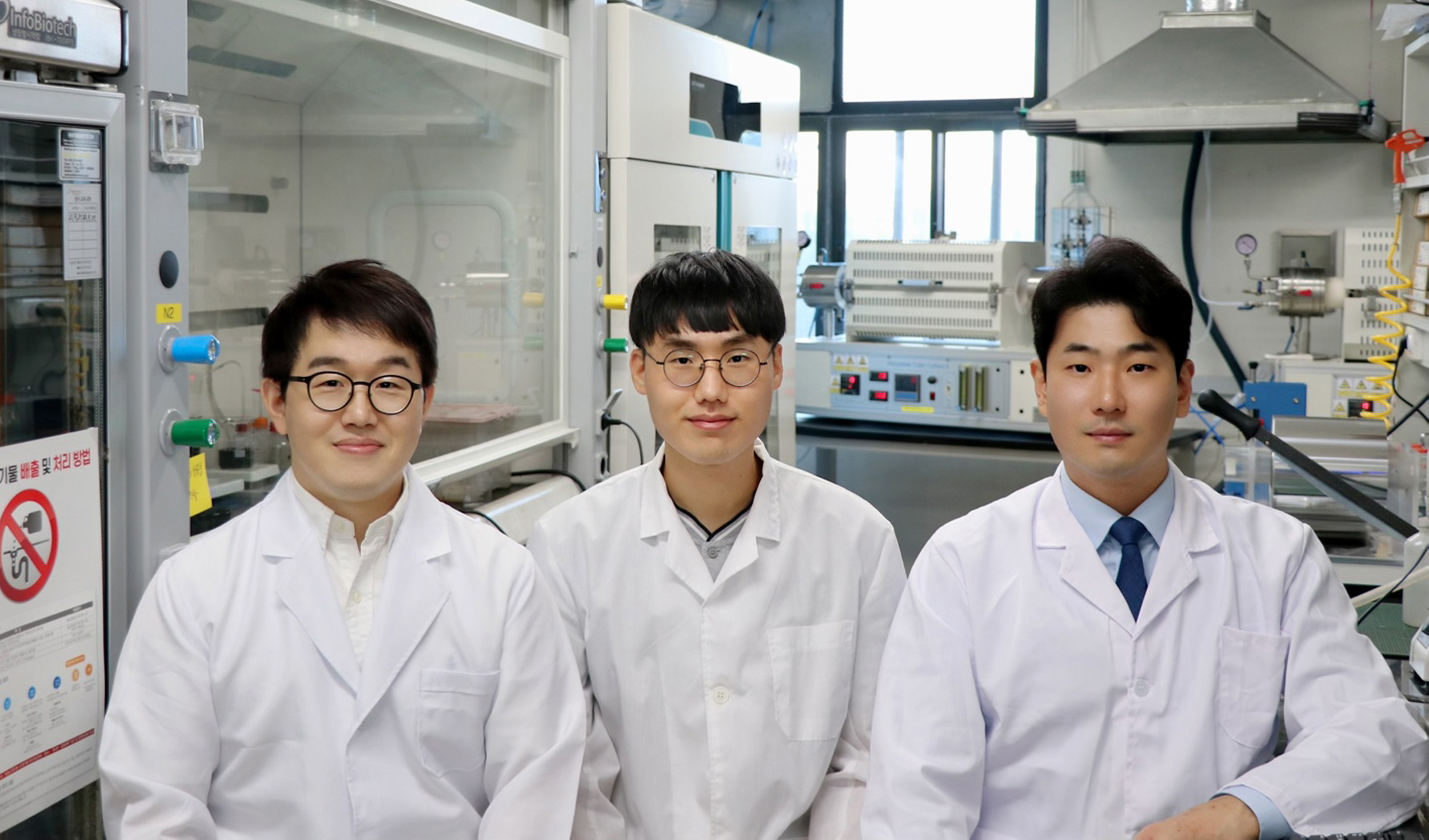연구소소식
Home > 자료실 > 연구소소식
차세대 이차전지 성능 높이는 새로운 방법(New approaches to improve the performance of next-generation secondary batteries)
작성일 : 2023-11-06
작성자 : 에너지융복합소재연구소
폐배터리 양극재, 차세대 이차전지 성능 높이는 촉매로 ‘변신’
- 부경대 고민성 교수팀, 국제학술지 <Journal of Materials Chemistry A> 논문 게재

△ 고민성 교수(오른쪽)와 연구팀.
폐배터리 처리에 관한 관심이 높아지는 가운데 폐배터리의 양극재를 차세대 이차전지의 촉매로 재활용할 수 있다는 흥미로운 연구 결과가 나왔다.
국립부경대학교 고민성 교수(금속공학전공) 연구팀은 폐리튬이온전지 양극재를 이용, 화재 위험성이 없어 차세대 대용량 에너지 저장장치로 주목받고 있는 바나듐 레독스 흐름전지의 고속 충·방전 특성을 향상하는 데 성공했다고 밝혔다.
바나듐 레독스 흐름전지의 전극은 반응이 일어나는 곳으로, 전지 성능에 중요한 역할을 한다. 전극에는 탄소물질이 주로 사용되지만, 가역성(어떤 상태로 변했다가 본 상태로 되돌아가는 성질)이 낮아 충·방전 시 전지 성능이 저하되는 문제점이 있다.
이 같은 문제를 해결하고 전지의 성능을 높이기 위해 전극의 반응속도를 높이는 촉매를 적용하는데, 고민성 교수팀은 폐리튬이온전지의 양극재를 그 촉매로 쓴 것이다.
연구팀은 폐리튬이온전지 양극재가 반복적인 충·방전에 의해 전자구조가 변화되고 산소 공공(空孔·vacancy)의 수가 증가한 상태라는 점에 주목했다.
완전 전지(full cell) 평가에서 촉매가 적용되지 않은 전극의 경우 높은 저항에 의해 281회의 고속 충·방전 이후 급격한 용량 저하를 나타냈다. 반면 촉매가 적용된 전극의 경우 폐리튬이온전지 양극재 특성이 반응물들의 산화환원 반응 시 저항을 크게 감소시켜 1,000회 이상 고속 충·방전을 가능하게 했다.
고민성 교수 연구팀은 미국 로렌스 버클리 국립연구소(LBNL) 장해성 박사와 공동 연구를 진행하고, 폐리튬이온전지 양극재를 탄소전극의 촉매로 적용해 높은 가역성과 향상된 고속 충·방전 특성을 갖춘 바나듐 레독스 흐름전지를 학계에 보고했다.
고 교수는 “이번 연구는 고속 충·방전 바나듐 레독스 흐름전지 개발은 물론, 폐리튬이온전지 양극재를 활용한 촉매설계에 기여하고, 폐리튬이온전지 발생량이 급증할 것으로 전망되는 상황에서 촉매로서의 재활용 방안을 제시해 자원순환 효과도 기대할 수 있다.”라고 말했다.
한편 이번 연구는 한국연구재단의 지원을 받아 이루어졌으며, 재료·에너지 분야 국제학술지인 <Journal of Materials Chemistry A> (IF=12.732)에서 우수성을 인정받아 2022년도 ‘주목할 논문(Hot paper)’으로 뽑힌 데 이어, 지난 9월 28일 36호의 표지 논문으로도 선정됐다. <부경투데이>

△ 모식도 이미지(바나듐 레독스 흐름전지 전극 촉매로의 폐리튬이온전지 양극재 재활용).

△ 국제학술지 <Journal of Materials Chemistry A> 표지 이미지.
Replacing the cathode of waste batteries as a catalyst to improve the performance of next-generation secondary batteries
- A team led by prof. Ko Min-Seong from PKNU published a thesis in the international scientific journal <Journal of Materials Chemistry A>
As interest in the use of waste batteries is growing, interesting research results have been presented that the cathode materials of waste batteries can be recycled as catalysts for next-generation secondary batteries.
A research team led by professor Ko Min-Seong from Pukyong National University (metallurgical engineering) announced that they have succeeded in improving the high-speed charging and discharging characteristics of vanadium redox-flow batteries, which are attracting attention as a next-generation large-capacity energy storage device because there is no fire risk, by using the cathode material of the waste lithium-ion battery.
The electrode of a vanadium redox flow battery is where the reaction takes place and plays an important role in battery performance. Carbon material is mainly used for the electrode, but there is a problem in that the performance of the battery during charging and discharging is deteriorated due to the low reversibility (the property of changing to a certain state and returning to the original state).
To solve this problem and improve the battery performance, a catalyst that usually increases the electrode reaction rate has to be applied, professor Ko Min-Seong's team used the cathode material of a spent lithium-ion battery as the catalyst.
The research team paid attention to the fact that the electron structure of the cathode material of the waste lithium-ion battery was changed by repeated charging and discharging, and the number of oxygen vacancies increased.
In the case of the electrode to which the catalyst was not applied in the evaluation of the full cell, the capacity decreased rapidly after 281 high-speed charging and discharging due to high resistance. On the other hand, in the case of a catalyst applied electrode, the characteristics of the cathode material of the spent lithium-ion battery greatly reduce the resistance when the redox reaction of the reactants occurs, enabling high-speed charging and discharging more than 1,000 times.
Professor Ko Min-Seong's research team conducted joint research with Dr. Jang Hae-Seong from Lawrence Berkeley National Laboratory (LBNL) in the US, and reported to academia on a vanadium redox-flow battery with high reversibility and improved fast charging and discharging characteristics by applying the cathode material of a waste lithium-ion battery as a catalyst for a carbon electrode.
He said, “This research is expected to contribute to the development of a vanadium redox-flow battery capable of high-speed charging and discharging, as well as a catalyst design using the cathode material of a waste lithium-ion battery. In the current situation where the amount of waste lithium-ion battery generation is expected to increase rapidly, recycling as a catalyst has been suggested as a novel alternative, so we can expect the effect of resource circulation.”
His research was supported by the National research foundation of Korea, and was selected as a ‘hot paper' in 2022 in recognition of its excellence in research in <Journal of materials chemistry A> (IF=12.732), an international academic journal in the field of materials and energy, and was also selected as the cover paper of the 36th issue published on September 28th. <Pukyong Today>
출처 : https://www.pknu.ac.kr/main/51?action=view&no=708048